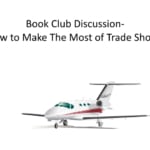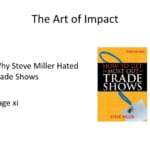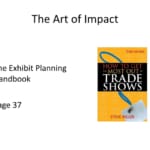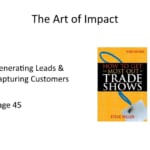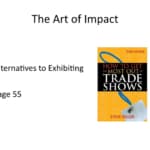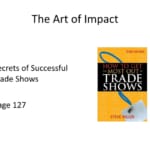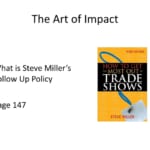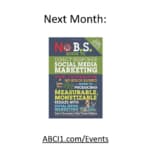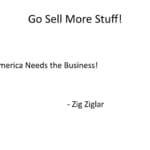Book club conversation – How to Get the Most out of Trade Shows by Steve Miller
Rich people have big libraries. Poor people have big TVs.
Jim Rohn
We discuss one popular book each month, from the perspective of the aviation industry!
Transcript – Book Club Discussion
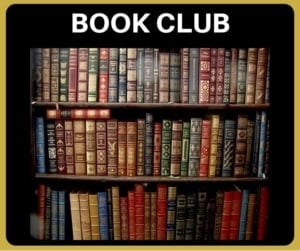 Paula Williams: Okay, so today we are doing our Book Club Discussion on How to Make The Most of Trade Shows, which was our selection for June, so hopefully people have had a opportunity to read it.
Paula Williams: Okay, so today we are doing our Book Club Discussion on How to Make The Most of Trade Shows, which was our selection for June, so hopefully people have had a opportunity to read it.
And think about it, and everything else, and trade shows are a huge thing in aviation aren’t they, John?
John Williams: Absolutely, they are.
Paula Williams: Okay, so you’ve been to aviation trade shows. What was your biggest first impression?
John Williams: The largess, everybody’s there. Well, in the national shows, NBAA, it’s unbelievably large.
Even the regionals are large.
Paula Williams: That’s true and NBAA is probably one of the biggest organizations that has aviation trade shows but they also have the EMT organization produces trade shows, HAI, the helicopter organization produces trade shows. There’s literally hundreds of them, and if you look at the Aviation Service Directory you can see, in our events calendar, not hundreds because we do try to keep it a little bit to a dull roar.
And we do have a bias toward those in the United States because most of our clients are here. But it is absolutely astonishing the number of aviation trade shows that have cropped up in the last what would you say 10, 15 years?
John Williams: Probably, AMT and NBAA there’s hundreds of millions of dollars of inventory there and that’s not counting the,
John Williams: Displays the NBAA.
Paula Williams: Exactly, I know they actually shut down the strip in Las Vegas when they have it there to bring the airplanes from McCarran Airport to the convention center. And I think in Orlando there’s something similar where they have a parade in the middle of the night [LAUGH] of airplanes in various states of disassembly coming down the street on their way to the event, which is almost as cool as the event itself, right?
John Williams: Well, I dunno about that.
Paula Williams: [LAUGH] But it’s pretty cool to see.
John Williams: It’s pretty amazing to watch if you stay up late and watch that happen.
Paula Williams: Exactly, so this is one of the most traditional, and one of the most respected forms of marketing in the aviation industry.
So, anyway, when we got into the book, I had to laugh when I got to the first part about why Steve Miller hated trade shows. And you know, he first started going to trade shows and his first impression was basically that it was so noisy and so chaotic that there was no way anybody could possibly do business here.
And also, the only reason that he thought his company was doing trade shows is because they couldn’t not do trade shows. If they ever stopped doing trade shows everybody would wonder why they’re not there, so.
John Williams: Which is a concern.
Paula Williams: [LAUGH] Which is a concern. So, he absolutely hated trade shows to start with before he started doing some work on turning that around and figuring out ways to make it more productive for himself but, I can totally sympathize, can you?
John Williams: It is very noisy, we’ve recorded interviews at those places and we tried it on the floor. [LAUGH]
Paula Williams: Yeah, those turned out to be almost unusable.
John Williams: But then, what we did we’d take those people and go to an unused room or hallway and the noise level is such that you can edit it out.
So it’ll work.
Paula Williams: Yeah, so I think the main thing is you just have to go in with a plan. And this book was actually really good preparation I think and really good timing, because if you’re starting now and you’re planning to go to the biggest show of the year, which is NBAA in October, you have a pretty good chance of getting your stuff together and going in knowing what to expect.
And also having a plan of what you’re going to do and not being phased by all this chaos and noise and ridiculousness, right?
John Williams: Yes.
Paula Williams: Okay, cool. So the first thing you have to do is set your budget. And the first year that we did trade shows we completely blew the lid off of our budget along with everything else, because we didn’t really know what to expect.
We’d been to trade shows in other industries but aviation is a little bit different.
John Williams: And pricier.
Paula Williams: [LAUGH] Pricier, the competition is different but everything costs money.
John Williams: Yes, if you’ve not been to one prepare to be shocked, not just at the cost, but at the fact that when you opt for a contract for a booth, that’s what you get is a space on the floor.
No carpet, no desk, no trash can. Nobody to back in the place at night, no electricity, no internet. Let’s see, what do you get? You get a backdrop to separate you from the other booths.
Paula Williams: [LAUGH] Right.
John Williams: And I think that’s about it.
Paula Williams: I think you get a little table, it depends on the show, but you get maybe a little, bare bones little table, and like a folding chair.
Or something along those lines but you really do want to-
John Williams: Something, pretty much, totally unusable.
Paula Williams: Right [LAUGH]. If your intention is to make a good impression, and it should be, and you’re planning on exhibiting in a trade show, then you really want to make sure that you plan that out.
And if you don’t plan to exhibit, and that is a perfectly fine option just to go to a show with the intention of networking and having other objectives besides exhibiting in a booth, then you still want to plan on your expenses and other kinds of things. And you really want to use a checklist to find out what’s expected, what’s provided, what costs extra, and read all those documents very carefully before you [INAUDIBLE] .
John Williams: You do get one other thing. They give you about a six inch by three foot, cardboard matte sign with your name on it.
Paula Williams: Right.
John Williams: [LAUGH].
Paula Williams: Exactly, we can’t forget that, but most people cover that up with their own [CROSSTALK].
John Williams: [CROSSTALK] give you anything to hang it with you have to do that yourself if you’re going to use it at all.
Paula Williams: Yeah, the first time we showed up there was that sign right there on the table and we hadn’t brought any wire. We hadn’t brought any duct tape, and we were-
John Williams: Scrambling.
Paula Williams: [LAUGH] Scrambling. A visit to Home Depot later, we’re somewhat up and running but yeah, you definitely want to make sure that you’re prepared.
And if this is your first trade show, what I’d really recommend is that you either hire somebody or get a buddy or something like that that has done that specific show before and has an idea of what is really expected. Okay, so setting your budget, there’s some really good information in the book I think, some checklist information.
And there’s also a checklist in our trade show checklist that you can download from our website that gives you a starting place to plan your budget. Okay, all right, in Steve Miller’s book, he actually has a pretty nice exhibit planning handbook that has a little bit different slant then our checklist.
It goes into a lot more detail about a lot of things and it’s a lot more general. So if you exhibited shows other than aviation shows, there’s might be handy for some of those purposes and things but you can’t be too prepared. And if you’re exhibiting I think the main thing is that you have to have thought through how are people going to approach your booth?
How are you going to attract their attention? Are they going to be able to see from a distance? What you do, and are they going to have a reason to come over to your booth, assuming that their first impression of your company is seeing your booth from across a crowded show floor, right?
John Williams: Actually, if you’re going to a trade show, you should start planning it by visiting the trade show first, without trying to actually display anything. Start at that point, because then, you see the traffic flow and it doesn’t change very much in Orlando for NBAA or Las Vegas for NBAA.
And you know what the traffic patterns are, then you can go to the people and say, I want to booth for next year and I want it in this location. And you’ll have a pretty good chance of getting it if you go there now, you’re going to get the drags, whatever’s left.
Paula Williams: Right, in fact you may, it may feel that [CROSSTALK].
John Williams: If you can get one at all.
Paula Williams: Exactly, so yeah, really, really important to plan your exhibit carefully and that goes for whether you’re doing a ten by ten or whether you’re doing a monster display. And I really recommend if it’s one of your first times at a show you want to start small or even don’t exhibit, plan on going with the intention of networking.
And look at some of the exhibits that you really like, and watch how they choreograph the whole flow of people coming into their booth. Shaking hands, doing product demos, those kinds of things but there’s no substitute for espionage. [LAUGH].
John Williams: And not only that but you have to plan your planning.
You have to plan how you’re going to do the social media for a trade show as well.
Paula Williams: That is true and in fact we just learned in next months book which is the No BS Social Media Book by Kim Walsh Phillips-
John Williams: For more interesting information on how to do that.
Paula Williams: Exactly, there’s some really cool technology that’s being used in trade shows nowadays that has never been done before so more about that in the future. All right, so generating leads and capturing customers after all this is why we are there, right?
John Williams: Precisely.
Paula Williams: Cool, so we’ve done a lot of work specially in recent webinars and other things about different ways to generate leads and capture customers.
And Steve Miller also has some really good information in the book that has some pretty novel ways of capturing people’s information. Of course a lot of the shows will try to sell you what they call a lead capture system.
John Williams: Yes, they will.
Paula Williams: What do you think of those, John?
John Williams: Nice try but-
Paula Williams: [LAUGH]
John Williams: They need something different.
Paula Williams: Right, come over here so I can scan your badge. And everybody has a little bar code on their badge and you feel like you’re being checked out at the grocery store when they check out your badge and scan it with those little bar code scanner.
And then it basically just puts information into a spreadsheet that you have to make sense of later. So, we really, since aviation is such a personal business and since most of the time we’re talking about large transactions and we’re talking about complex transactions, you really want to make fewer contacts.
But, you want to take lots of notes. So however you can do that discretely if you do that on your phone or if you do that on a notepad or whatever, you really want to remember after the show when you get home have a little bit more than just a name and a number or a name and an email address and stuff like that.
Because you want to do better than just spamming these people, you want to make sure that you’ve got enough information to say we talked about this. I know you’re from this company, let’s continue that conversation now that you’re home and have time. So here are some of the things that you asked about, and here’s some more information.
 So you want to be really, really customized with those kinds of things, so good stuff. Alternatives to exhibiting, also good, we had talked about this in, in our last webinar as well. Some of the really cool ways of doing this are to have some kind of a reason to visit people’s booths and pick up their business cards shake their hand and make that kind of connection.
So you want to be really, really customized with those kinds of things, so good stuff. Alternatives to exhibiting, also good, we had talked about this in, in our last webinar as well. Some of the really cool ways of doing this are to have some kind of a reason to visit people’s booths and pick up their business cards shake their hand and make that kind of connection.
At most trade shows they don’t actually allow you to distribute materials unless you-
John Williams: Have rented a booth.
Paula Williams: Unless you have rented a booth. That’s kind of their way of getting additional revenue from the show. So you want to be discreet and you want to be very targeted about the way that you do this.
So if you have a list of exhibits at the show and you look at your top 10 most wanted customers or top 20 or top 30 or however many you have time to plan. And you plan an approach for each of those people. That might be something along the lines of I saw in the news that you were rolling out a new product, and I have something that may be of interest to you for that reason.
So you want to be really, really super targeted, and really informed before you make those approaches, right?
John Williams: Yeah [COUGH], and if you can limit to the top ten, with select alternatives, you could always plan for a dinner while you’re there.
Paula Williams: That’s true.
John Williams: Well, we’ve done that.
Paula Williams: Yeah, exactly. So, if there are maybe ten people that you really, really want to meet with, you can invite them to an event of your own that is off site, so that’s a wonderful thing. And you may want to invite them together especially, if they’re existing customers, and your purpose is to cement those relationships.
And maybe acquire testimonials or sell them an upgrade, or whatever your intention is with each of those customers. You might want to put them together in a room.
John Williams: Yeah, cuz prospective clients or customers who then talk to guys that are already there and that’s, you can just stand back and sip your drink and let it happen.
Paula Williams: [LAUGH] Exactly, let them do the work for you, right? Because you’re there to socialize so you know that happens pretty naturally and that’s a good way of doing this. Telemarketing, now this is something that I had never really put together with trade shows. But, it can be really effective, before and after the show.
So to start with, if you have a list of your top ten most wanted customers, you can call them, put together a really nice outline of the things that you want to talk to them about before you get to the show, so that they’re expecting your visit or you’ve already made an appointment.
That’s a really good way to maximize your time, make sure you get your schedule booked solid so that you’re making a good use of that expense of being there. So telemarketing ahead of the show if you’re exhibiting of course you want to go through your whole client list. And you want to talk to everybody that you possibly can and say are you going to be in Orlando for NBAA?
We’re going to be there, we’re going to be in booth number blah and you should come by because and fill in the blank, right?
John Williams: So they have a booth number, blah?
Paula Williams: [LAUGH] You should come by our booth number 497.
John Williams: [LAUGH]
Paula Williams: And whoever has booth number 497’s going to get a lot of-
John Williams: [COUGH]
Paula Williams: Unsolicited [LAUGH] visits and here’s why you should come and visit us, and tell them about the contests that you’re having or the product demo that you’re doing, or whatever it is that you have planned. So telemarketing ahead of the show, very very important. A lot of people do this with postcards But not very many people do it with the phone, right?
John Williams: Not many people do it at all.
Paula Williams: Not many people do it at all. So I think the phone is going to be a lot more effective for you because then you’re actually kind of having a personal touch there.
John Williams: Particularly, if you already have a reason to talk to folks.
Paula Williams: Right, and everybody on your prospect list. You want to make sure that you talk to them and say, I know you’ve been talking with us about this product for a while and you’ve been looking into it, let’s sit down and have a look at it in person while you’re here.
So we’re going to be in booth we’re going to be in this location. Let’s put you down for an appointment, so that I can devote my time to you. And, a lot of booths will have kind of a secluded area where you can actually have a conversation without all the noise and hubbub going on.
And then you can serve them a drink, you can go through your product demo in person and be a lot more effective that way. After the show some people will go through their list and make one phone call. How many phone calls do you get after dropping cards at a show, John?
John Williams: Zero.
Paula Williams: Zero? Not one?
John Williams: Never.
Paula Williams: I get some. I get, if I’ve dropped 100 cards I might get three or four calls. So, but I drop a lot more cards than you do, because I’m trying to win all the contests. [LAUGH]
John Williams: Well, the interesting thing is, in one of our presentations or podcasts is a list of how many contacts you need to make to make a sale.
Paula Williams: Right, that’s a pretty famous list.
John Williams: I don’t know where it’s from, but the number is much higher than you would think.
Paula Williams: Right and in the aviation industry it’s even higher than that.
John Williams: Right.
Paula Williams: So the very basics of what people advise that you do with aviation trade shows is just go through your list and make a call to everybody.
And thank them for coming by your booth, let them know if they won the contest or whatever it is and follow up with any questions that they have. That’s the bare minimum that you should be doing. You know we recommend a much more customized approach and that really depends, like we talked about, on having extensive notes on everybody that visited your booth and getting really good at doing that well and discreetly.
When we have done booths, we alternate so that I talk to somebody, then I get to go make notes for a couple of minutes while somebody else takes care of the next person. And then that way, we have really good notes about each conversation and each person that visited and the things that we talked about, so that I remember after the show.
This is what this person looks like, this is where they’re from and what their concerns and questions were.
John Williams: And the other thing along with that is this is part of the sales. But, don’t deselect somebody from calling them because you don’t think they’ll buy.
Paula Williams: [LAUGH]
John Williams: Let them talk you out of it first.
Paula Williams: Right, there’s a book called Go for No and that’s actually a pretty decent sales strategy, I think that’s a Sandler thing, right?
John Williams: Yes, well a number of folks do it but yes. Anyway I would just add that in there as part of the call up thing.
Paula Williams: Exactly, and there is nothing wrong in fact in our first conversation on a phone call as a follow up is it is perfectly fine to tell me that you’re not interested. And if that’s the case then I’m going to cross you off my list and I won’t bother you again.
But if you do have an interest I want to make sure that we’re answering your questions and taking it to the next step. All right cool, so secrets of successful trade shows, what’s your top three lists maybe, or top one?
John Williams: If we’re going to an aviation trade show, if we’re going to have a booth?
Paula Williams: Well, let’s do one for exhibitors and one for networkers.
John Williams: [SOUND]
John Williams: Well, if I’m going to exhibit.
John Williams: I think the top number one secret which I can whisper is planning, and about a year in advance minimum. Because that way, when you get there, you just execution.
Paula Williams: Right, so then you can relax, and you’re not sweating the details, when you should be socializing and spending time with customers.
John Williams: Well, and you’ve got everything in place, you know you’re comfortable, and you can concentrate on drawing people into the booth. And you know you’re going to have some people show up anyway, so.
Paula Williams: And you’re not messing with the extension cords and duct tape while people are [LAUGH] coming to the booth that you should be socializing with.
John Williams: No.
Paula Williams: True, good point. All right, how about for networkers? Number one tip.
John Williams: Probably revolve around planning as well. Because every show nowadays has got a Twitter board up somewhere, they’ve got email.
There’s all kinds of stuff going on with Facebook and everything else. The trade shows, they’ll have even, I forget what they call them but where you meet people to network, for that purpose.
Paula Williams: Like coffee socials, and mixers-
John Williams: So yeah, and you need to have planned and know where look for and then join those before you ever get there.
Paula Williams: Right, so have a schedule for yourself. You might want to keep it flexible because there’s always weird things that happen. But, have a schedule for yourself, I think that’s really important and I totally agree
Paula Williams: My number one tip, especially for networkers, well actually for everyone, is to have a fantastic 15 second sales presentation for when people ask you what do you that should just roll off your tongue really easily.
You shouldn’t be stammering and staring at your shoes and have the deer in the headlights look. Because you’re there for a reason, it’s not like the trade show is a surprise to you.
John Williams: [LAUGH]
Paula Williams: You were expecting to be asked this question. And it really should be polished, and it should be professional.
And it doesn’t have to sound stilted. In fact, the more you practice this, the better it gets.
John Williams: Sure, so just be confident. I sell ducks, why what do you do?
Paula Williams: [LAUGH] Exactly, so.
John Williams: [COUGH]
Paula Williams: What, somebody asks you John, what does ABCI do?
John Williams: We sell marketing.
Paula Williams: We help aviation companies-
John Williams: [LAUGH]
Paula Williams: Sell more of their products and services.
John Williams: I knew you were going to do that, that’s the reason I did that, so you could [LAUGH]
Paula Williams: I know. Yeah, we don’t sell marketing. [LAUGH]
John Williams: [COUGH] Excuse me.
Paula Williams: That was good [LAUGH] actually, and really you should think about it from the customer’s perspective.
What do you do, how do you help people? And there’s an outline that we’ll link to from our website that talks about some suggested outlines for those 15 second sales presentations.
John Williams: And actually she’s right. She’s been in marketing for 25 or more years and I’ve been to probably every sales course in the books all the way around.
And I don’t consider myself to be a good salesperson, however, I know what you should be doing and can show you how to do it.
Paula Williams: Exactly, all right, so good secrets. All right, so what is Steve Miller’s follow up policy?
John Williams: Follow up. [LAUGH]
Paula Williams: Do it.
Right, exactly. And I think he follows too, the same tenets as what we recommend, so we’ll emphasize the things we agree on, right? One of them is that you’re really looking to disqualify people as quickly as possible so if someone doesn’t have an interest in your product or service you’re not spending a lot of time and money following up with people who don’t have the money authority or need for your product.
That’s thing number one. And thing number two is if somebody is qualified then of course you want to stick with them for as long as it takes. And that would be newsletters, that would be phone calls, that would be anything that you can do, in your sales process to stay connected with them, in general at least once a week, while they’re going through the process.
Unless they tell you, I’m going to be interested at the beginning of the second quarter, when my budget comes due, or whatever. In which case, you’re going to want to send them really low-key materials like newsletters and so on, just so that they don’t forget about you in the interim, right?
John Williams: Mm-hm.
Paula Williams: Okay, cool! So good book, what do you think, scale of one to ten?
John Williams: I think with respect to aviation it’s probably nine and a half.
Paula Williams: Wow, okay, yeah, I think I’d give it probably a seven. We did get some comments from some folks in the class that it is a little bit dated.
Which is true but as books go, books are always dated and I love books.
John Williams: [LAUGH]
Paula Williams: [LAUGH] Because you can really sink your teeth into some subject matter, in a way that you really can’t with all the flotsam and jetsam on the Internet. So the fact that is a book, gives it permission to be somewhat dated in my mind.
What do you think John?
John Williams: Yep. Those are always good.
Paula Williams: True, speaking of dated, [LAUGH] this is the hardest subject to write a book about. Next month, we’re going to be talking about the No BS Guide to Direct Response social media marketing by Kim Walsh Philips. And we’re actually glad to have Kim on our podcast.
I’m really looking forward to that interview that’s going to be a lot of fun. We met her actually several times she is part of a networking marketing group that we belong to. And she has some really fantastic ideas about some really new technology so that’s going to be cool. So, go sell more stuff.
John Williams: Yep, America Needs the Business! By Zig Ziglar.
Paula Williams: Yeah, right [LAUGH] absolutely, so have a great week and we’ll talk to you again soon.
John Williams: Ciao.
John Williams: [COUGH] It’s down to the last bar. I’ll change the batteries before the next one.
Paula Williams: Uh-oh.
John Williams: What?
Paula Williams: I don’t think this was recording.
I saw it count down though. Well, good thing
AMHF 0036 – Aviation Marketing Trade Show Secrets –
The biggest aviation trade show marketing secrets are not really secrets. In fact, it’s those very things that you think should be SO OBVIOUS but NOBODY SEEMS TO DO THEM. In decades of attending aviation trade shows as a buyer, seller, and consultant, we see that maybe ten percent of companies actually do what they say they know they should do.
Aviation Trade Show Disasters and How to Avoid Them
Trade shows are a huge, and very powerful part of the marketing plans for MANY aviation companies. Of course, they are also a big investment. We talk about four common trade show mistakes and what to do instead.
Aviation Trade Shows – A Book Club Discussion – Trade shows by Steve Miller
Book club conversation – How to Get the Most out of Trade Shows by Steve Miller
Rich people have big libraries. Poor people have big TVs.
Jim Rohn
We discuss one popular book each month, from the perspective of the aviation industry!
..

